Isn't Japan's pop declining? How will they meet manpower requirements with that?That's not actually true AFAICT. The new Maya class destroyers have exactly the same 300 man crew size as the older Kongo and Atago destroyers. The new Taigei submarines have 5 more crew members than the Soryus.
"All of this means that Japan’s relatively small forces are now even smaller. The armed services have hit on average only 70 percent of their recruitment goals, with the MSDF hitting a dismal 60 percent."
I again reiterate that the JMSDF cannot get the sailors it needs to keep the fleet the same size, let alone expand it.
Germany is mentioned here because it is an example of a country that has shrunk its military in both equipment and manpower.
You are using an out of date browser. It may not display this or other websites correctly.
You should upgrade or use an alternative browser.
You should upgrade or use an alternative browser.
I liked your post because of the degree of babbling you took to misrepresent the whole post all for a very slight correction. The nature permitted on the forums for feel-good ranting as means to vent frusturation of the reality if the colossal China containment that's going on now.
Oops, I just got suckered into reciprocating, even if just slightly, to trap me into moderator discipline. Last tine it was for sayibg Japan would cone to defend Taiwan and sore loser cry babies saying was off topic. Well it only took a few months.
Keep babbling losers.
If there's jap, then there's chicom.
If there's weerbo, there's dog.
Chicom dog.
Spell this...
C H I C O M D O G
...
Unfortunate, because the posts you made those replies to were posts made in relatively constructive manners and you chose to reply like this.
Official warning, one year ban.
====
To everyone else, cool off a little bit. Any further posts from this particular chain of discussion will be warned and deleted as appropriate.
this is typical japs view of the world, where did you get your numbers? fingering yourself?
"Jap" is a slur, and not acceptable here.
You used it once in isolation, so it will be a one month ban, but let this be a signal to yourself and others that use of those slurs is not welcome here.
I suppose they can make a 90 person warship but it'd likely be a sub 2k ton corvette. If war does come I don't think the Mogamis will cover themselves in glory. The USN has already concluded that understaffed major surface warships are not worth building and from what I can gather the Russians and Chinese also agree.
It is possible to "run" a 3k+ ton multi-mission frigate with a crew of 70+
The major point conceded with that crewing arrangement, as you mentioned, is that on a war footing, the above will be left wanting on station persistence and damage control.
But consider this. Not all Navies operate on a round-the-clock war footing.
The above mentioned FFG has bunking space to surge crew way past normal manning rates. Given sufficient notice, reserve personnel will be tapped to fill those bunks and bring manning level to a "war" footing. FFNW so to speak.
Pro/Con, you keep peace time cost down while retaining war fighting capabilities at the expense of vulnerability in time taken to shift stance.
I think the JMSDF may be taking this approach? Won't know for sure until one has a chance to take a ship tour and count the bunk space available
It is possible to "run" a 3k+ ton multi-mission frigate with a crew of 70+
The major point conceded with that crewing arrangement, as you mentioned, is that on a war footing, the above will be left wanting on station persistence and damage control.
But consider this. Not all Navies operate on a round-the-clock war footing.
The above mentioned FFG has bunking space to surge crew way past normal manning rates. Given sufficient notice, reserve personnel will be tapped to fill those bunks and bring manning level to a "war" footing. FFNW so to speak.
Pro/Con, you keep peace time cost down while retaining war fighting capabilities at the expense of vulnerability in time taken to shift stance.
I think the JMSDF may be taking this approach? Won't know for sure until one has a chance to take a ship tour and count the bunk space available
Well, we see commercial tankers running with crews of 20.
Then you would need to add
a bridge crew (10)
a CIC crew (10)
helicopter crew (20?)
You're already at 60 people, and what about all the other weapons systems which break down or need maintenance?
I suppose they can make a 90 person warship but it'd likely be a sub 2k ton corvette. If war does come I don't think the Mogamis will cover themselves in glory. The USN has already concluded that understaffed major surface warships are not worth building and from what I can gather the Russians and Chinese also agree.
US shipbuilding is decades behind Asian or even European shipbuilding standards. Automation went a long way and the days of enlists going trough the engine room to read and write down values from the sensors are long gone - at least outside of the USA.
Let me share something I made a few weeks ago. It's based on Wikipedia so it can be out of date but the historical data is correct. It should help in better understanding of what the Japanese navy is, how it operates and why it makes the procurement choices it does. I'll focus on the main surface fleet as submarines and other surface vessels are not relevant to the subject.
Japanese navy is divided into five naval districts each commanding two "Fleet Escort Force" squadrons and one "District" squadron. These districts have commands in Yokosuka, Kure and Sasebo in charge of Pacific waters, Maizuru in charge of Sea of Japan and additional district command in Ominato in the North at the border with Russia.
Nominally each FEF squadron has four destroyers - 1 AEGIS (DDG) and 2-3 ASW (DD) while one of the squadrons also has a helicopter carrier (DDH) instead of one of the DDs. Kure and Maizuru districts arrange the ships differently most likely for operational reasons.
The third squadron is outside FEF command and serves as territorial patrol force. Those squadrons have three ships each from the oldest classes of destroyers and the destroyer escorts (DE).
Here's the diagram of all the districts and ships - class name in red:
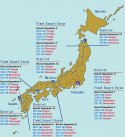
Here's the historical chart which includes all major surface combatants from 1971 onward. Dark blue indicates ships in service. Light blue indicates ships out of service. The number indicates cumulative years in service. Ships are split into classes. Topmost table has combined numbers for ship types. Yellow and grey rows indicate consecutive years. I made a few minor errors but they are not important for current events. The most notable is incorrect age for Asagiri DDs - you can see where the formula was incorrect, just add 10 years.
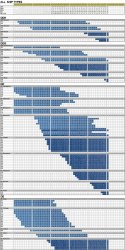
If you look closely and compare the types being introduced and total numbers in service per type you will see that there is a consistent trend - buildup in the 70s and the 80s which focuses on less capable ships first, then in the 90s the introduction of AEGIS destroyers instead of traditional AAW destroyers and full-deck helicopter carriers instead of traditional ships with enlarged helo decks. The numbers of ships fulfilling missions stay mostly the same as the missions shift from less to more capable vessels, especially with the introduction of Hatsuyki class in late 80s. That was the Japanese shipbuilding boom. Any future replacements are also following the same trend and that's because Japan's maritime and naval doctrine hasn't significantly changed since the 70s.
Below I complied all DD and DE classes of Japanese navy - you can clearly see which is a development of which. Asahi is an AAW version of ASW Asagiri and Takanami is an update to Murasame. I did not include DDGs because they are all variations on base Arleigh Burke design with minor changes.
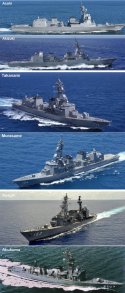
The quickest way to remember Japanese DD's is this:
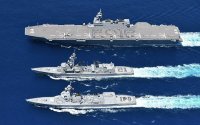
Abukuma is a DE (destroyer escort - patrol frigate equivalent) which is useless, small, has no TASS, no SAM and only basic sensors. It's a Harpoons and ASROC sloop not a warship. It remains in service because it still has service life and is cheap.
The first batch of 8 Mogami's will replace oldest destroyers and Abukuma DE's in the district squadrons and Asagiri DD's in FEF squadrons because of the age of those ships. Neither Abukuma or Asagairi classes are what we could call "combatant" classes. They are ASW escort/patrol ships. Abukuma has no SAM, and Asagiri has Sea Sparrow.
Mogami's main role will be identical to those two - it is primarily a ship for general patrol duties and for towing of passive array. The other sensors and Mk.41 are for standardization of equipment and CEC (cooperative engagement capability) as part of a task force with capital ships. Mogami's are not even on the level of Asahi let alone Maya in terms of capability. Lots of new and innovative electronic and mechanical solutions - yes. Matching firepower and battlespace awareness - no.
Considering Mogami's core mission 90 people are plenty, especially that we don't know if the figure includes aircrews as they are often not included. For comparison the Russian Steregushchiy class which is a smaller (size-wise) but identical in mission profile has also a complement of 90 people and the upgraded Gremyashchiy with better radars and more SAMs has only 100.
Or we can compare complements on Japanese ships:
Displacement is misleading because size helps and steel is cheap. Hull is the lowest cost element in modern warship construction so it is a correct choice to overbuild in terms of space and displacement. It makes everything easier to arrange, it makes the ship more survivable and it makes it more future-proof. Unlike say Arleigh Burke which was cut down to size in its first batch and because of that now struggles to accomodate newer systems because of lack of available space.
Japan plans to build 22 frigates of this class which means they will replace all Abukuma's (6 in service), all Hatsuyuki's (2), all Asagiri's (8) and six Murasame's (9). All of these ships are general purpose patrol vessels and basic ASW escorts. They are not high-capability ships. Their main purpose is to deliver sensors to area of operations and perform basic patrol tasks in peacetime.
In conclusion - I don't see what kind of problem some of you have with the Mogami. It's a reasonable choice with some interesting features that fits a long-term trend. Considering all the other economic and demographic factors it is a conservative, sustainable option.
-----------------------------------------------------------------------------------------
As bonus - here's the timeline of Japanese submarine production. As before: dark blue- in service, light blue - retired, numbers - cumulative years in service.
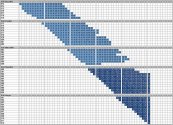
The current plans for production of Taigei's maintain the rate of 1 submarine annually which means Japan is going to retire Oyashio's after ~20 years in service. I wonder if the capabilities of new subs will justify this decision or whether it will be the usual jobs & spending program.
----------------------------------------
I am sorry but I don't know how to make the first table more legible. It's 1280px wide and it reads OK as a file but not here.
Japanese navy is divided into five naval districts each commanding two "Fleet Escort Force" squadrons and one "District" squadron. These districts have commands in Yokosuka, Kure and Sasebo in charge of Pacific waters, Maizuru in charge of Sea of Japan and additional district command in Ominato in the North at the border with Russia.
Nominally each FEF squadron has four destroyers - 1 AEGIS (DDG) and 2-3 ASW (DD) while one of the squadrons also has a helicopter carrier (DDH) instead of one of the DDs. Kure and Maizuru districts arrange the ships differently most likely for operational reasons.
The third squadron is outside FEF command and serves as territorial patrol force. Those squadrons have three ships each from the oldest classes of destroyers and the destroyer escorts (DE).
Here's the diagram of all the districts and ships - class name in red:

Here's the historical chart which includes all major surface combatants from 1971 onward. Dark blue indicates ships in service. Light blue indicates ships out of service. The number indicates cumulative years in service. Ships are split into classes. Topmost table has combined numbers for ship types. Yellow and grey rows indicate consecutive years. I made a few minor errors but they are not important for current events. The most notable is incorrect age for Asagiri DDs - you can see where the formula was incorrect, just add 10 years.

If you look closely and compare the types being introduced and total numbers in service per type you will see that there is a consistent trend - buildup in the 70s and the 80s which focuses on less capable ships first, then in the 90s the introduction of AEGIS destroyers instead of traditional AAW destroyers and full-deck helicopter carriers instead of traditional ships with enlarged helo decks. The numbers of ships fulfilling missions stay mostly the same as the missions shift from less to more capable vessels, especially with the introduction of Hatsuyki class in late 80s. That was the Japanese shipbuilding boom. Any future replacements are also following the same trend and that's because Japan's maritime and naval doctrine hasn't significantly changed since the 70s.
Below I complied all DD and DE classes of Japanese navy - you can clearly see which is a development of which. Asahi is an AAW version of ASW Asagiri and Takanami is an update to Murasame. I did not include DDGs because they are all variations on base Arleigh Burke design with minor changes.

The quickest way to remember Japanese DD's is this:
- 5200-6800t full displacement.
- primary ASW escorts with TASS. Only Akizuki has AAW role (see the four AESA panels on bow and aft structure) as cheaper substitute for DDGs and has no towed array.
- AESA radars. Akizuki and Asahi have four-side GaN AESA radars while Murasame and Takanami have rotating single-panel AESA.
- ESSM only, can't fire SMs including Akizuki. Asahi, Akizuki and Takanami have 32 Mk41s, Murasame has 16 Mk48s for ESSM and 16 Mk41 for ASROC and Asagiri uses Sea Sparrow.

Abukuma is a DE (destroyer escort - patrol frigate equivalent) which is useless, small, has no TASS, no SAM and only basic sensors. It's a Harpoons and ASROC sloop not a warship. It remains in service because it still has service life and is cheap.
The first batch of 8 Mogami's will replace oldest destroyers and Abukuma DE's in the district squadrons and Asagiri DD's in FEF squadrons because of the age of those ships. Neither Abukuma or Asagairi classes are what we could call "combatant" classes. They are ASW escort/patrol ships. Abukuma has no SAM, and Asagiri has Sea Sparrow.
Mogami's main role will be identical to those two - it is primarily a ship for general patrol duties and for towing of passive array. The other sensors and Mk.41 are for standardization of equipment and CEC (cooperative engagement capability) as part of a task force with capital ships. Mogami's are not even on the level of Asahi let alone Maya in terms of capability. Lots of new and innovative electronic and mechanical solutions - yes. Matching firepower and battlespace awareness - no.
Considering Mogami's core mission 90 people are plenty, especially that we don't know if the figure includes aircrews as they are often not included. For comparison the Russian Steregushchiy class which is a smaller (size-wise) but identical in mission profile has also a complement of 90 people and the upgraded Gremyashchiy with better radars and more SAMs has only 100.
Or we can compare complements on Japanese ships:
- Abukuma (DE) - 120
- Asagiri (DD) - 220
- Murasame (DD) - 165
- Takanami (DD) - 175
- Asagiri (DD)(AAW) - 200
- Asahi (DD) - 230
Displacement is misleading because size helps and steel is cheap. Hull is the lowest cost element in modern warship construction so it is a correct choice to overbuild in terms of space and displacement. It makes everything easier to arrange, it makes the ship more survivable and it makes it more future-proof. Unlike say Arleigh Burke which was cut down to size in its first batch and because of that now struggles to accomodate newer systems because of lack of available space.
Japan plans to build 22 frigates of this class which means they will replace all Abukuma's (6 in service), all Hatsuyuki's (2), all Asagiri's (8) and six Murasame's (9). All of these ships are general purpose patrol vessels and basic ASW escorts. They are not high-capability ships. Their main purpose is to deliver sensors to area of operations and perform basic patrol tasks in peacetime.
In conclusion - I don't see what kind of problem some of you have with the Mogami. It's a reasonable choice with some interesting features that fits a long-term trend. Considering all the other economic and demographic factors it is a conservative, sustainable option.
-----------------------------------------------------------------------------------------
As bonus - here's the timeline of Japanese submarine production. As before: dark blue- in service, light blue - retired, numbers - cumulative years in service.

The current plans for production of Taigei's maintain the rate of 1 submarine annually which means Japan is going to retire Oyashio's after ~20 years in service. I wonder if the capabilities of new subs will justify this decision or whether it will be the usual jobs & spending program.
----------------------------------------
I am sorry but I don't know how to make the first table more legible. It's 1280px wide and it reads OK as a file but not here.
Last edited:
SamuraiBlue
Captain
Mogami type has a dual role as a mine sweeper utilizing a USV and a UUV.
Below I complied all DD and DE classes of Japanese navy - you can clearly see which is a development of which. Asahi is an AAW version of ASW Asagiri and Takanami is an update to Murasame. I did not include DDGs because they are all variations on base Arleigh Burke design with minor changes.
View attachment 78256
The quickest way to remember Japanese DD's is this:
Here's a picture of Izumo DDH with Asahi DD (late 2010s) and Murasame DD (mid 1990s) - the destroyers are almost identical in terms of hull and general layout. They are in essence the same ship just with upgraded systems.
- 5200-6800t full displacement.
- primary ASW escorts with TASS. Only Akizuki has AAW role (see the four AESA panels on bow and aft structure) as cheaper substitute for DDGs and has no towed array.
- AESA radars. Akizuki and Asahi have four-side GaN AESA radars while Murasame and Takanami have rotating single-panel AESA.
- ESSM only, can't fire SMs including Akizuki. Asahi, Akizuki and Takanami have 32 Mk41s, Murasame has 16 Mk48s for ESSM and 16 Mk41 for ASROC and Asagiri uses Sea Sparrow.
View attachment 78261
Abukuma is a DE (destroyer escort - patrol frigate equivalent) which is useless, small, has no TASS, no SAM and only basic sensors. It's a Harpoons and ASROC sloop not a warship. It remains in service because it still has service life and is cheap.
The first batch of 8 Mogami's will replace oldest destroyers and Abukuma DE's in the district squadrons and Asagiri DD's in FEF squadrons because of the age of those ships. Neither Abukuma or Asagairi classes are what we could call "combatant" classes. They are ASW escort/patrol ships. Abukuma has no SAM, and Asagiri has Sea Sparrow.
Mogami's main role will be identical to those two - it is primarily a ship for general patrol duties and for towing of passive array. The other sensors and Mk.41 are for standardization of equipment and CEC (cooperative engagement capability) as part of a task force with capital ships. Mogami's are not even on the level of Asahi let alone Maya in terms of capability. Lots of new and innovative electronic and mechanical solutions - yes. Matching firepower and battlespace awareness - no.
Considering Mogami's core mission 90 people are plenty, especially that we don't know if the figure includes aircrews as they are often not included. For comparison the Russian Steregushchiy class which is a smaller (size-wise) but identical in mission profile has also a complement of 90 people and the upgraded Gremyashchiy with better radars and more SAMs has only 100.
Or we can compare complements on Japanese ships:
As you can see a basic patrol/ASW frigate with 90 people is not that far off an early 90s DD with 165.
- Abukuma (DE) - 120
- Asagiri (DD) - 220
- Murasame (DD) - 165
- Takanami (DD) - 175
- Asagiri (DD)(AAW) - 200
- Asahi (DD) - 230
Displacement is misleading because size helps and steel is cheap. Hull is the lowest cost element in modern warship construction so it is a correct choice to overbuild in terms of space and displacement. It makes everything easier to arrange, it makes the ship more survivable and it makes it more future-proof. Unlike say Arleigh Burke which was cut down to size in its first batch and because of that now struggles to accomodate newer systems because of lack of available space.
Japan plans to build 22 frigates of this class which means they will replace all Abukuma's (6 in service), all Hatsuyuki's (2), all Asagiri's (8) and six Murasame's (9). All of these ships are general purpose patrol vessels and basic ASW escorts. They are not high-capability ships. Their main purpose is to deliver sensors to area of operations and perform basic patrol tasks in peacetime.
In conclusion - I don't see what kind of problem some of you have with the Mogami. It's a reasonable choice with some interesting features that fits a long-term trend. Considering all the other economic and demographic factors it is a conservative, sustainable option.
Just to clarify, only the Asahi class have the GaN AESA radars. Akizuki has AESA radars but its using GaAs, which is commonly used with earlier AESAs.
Even if Asahi class is for ASW, its AAW capabilities isn't behind that of the Akizuki, and with the improved radars, its likely better than the Akizuki.
Choice of radar bands is unconventional, with C-band being used. C-band does not have the range of S-band, nor the resolution of X-band. Its likely C-band is used because the AESAs are multi-role between search and fire control, whereas the more conventional naval radar arrangement is to have separate both S band for search and X-band for fire control. To have separate and dedicated S and X-band radars are an easier design decision in the earlier days when both are mechanical radars, and when AESAs came to have only one AESA and one mechanical but it becomes ghastly expensive when both S and X-band radars are AESAs. Keep this in mind when we talk about the Mogami. The Akizuki and Asahi class does have X-band radars, but these are tiny are used for missile target illumination.
The Mogami only has X-band AESA radars. The choice of having only one set is easy in order to keep costs low, same reason Zumwalt sacrificed its S-band AESA and kept only its X-band AESA. Same set does fire control and search. At this point in time, even without it being advertised, it should be assumed that GaN is used, as we are already deep into next generation AESA designs, and there is no point in using GaAs, not even for economic reasons.
However the choice of using C and X-band radars is sure to limit the maximum air search ranges, and both C and X-band are more vulnerable to stealth technologies than you do with S and L-bands. But if the ship's role is ASW, then its expected that some other ships, like the AEGIS ones, to handle the long range air search.
Mogami's large dildo like ESM is more interesting, as this suggests the ship is leaning more for passive radar as a means for situational awareness and threat detection. This is in line with the trend of greater use of passive radar or ESM as we are seeing in a number of recent ships.
